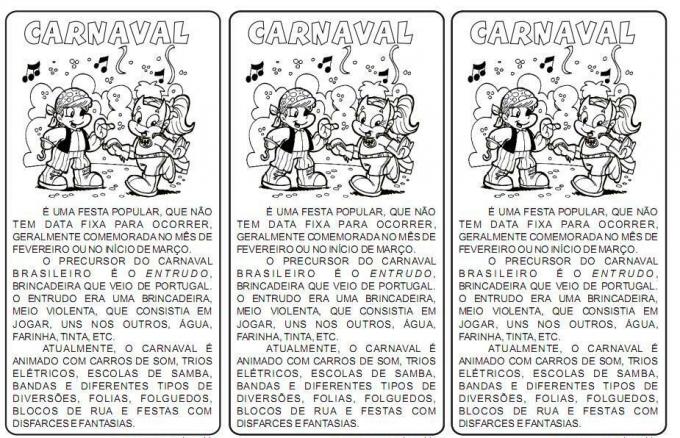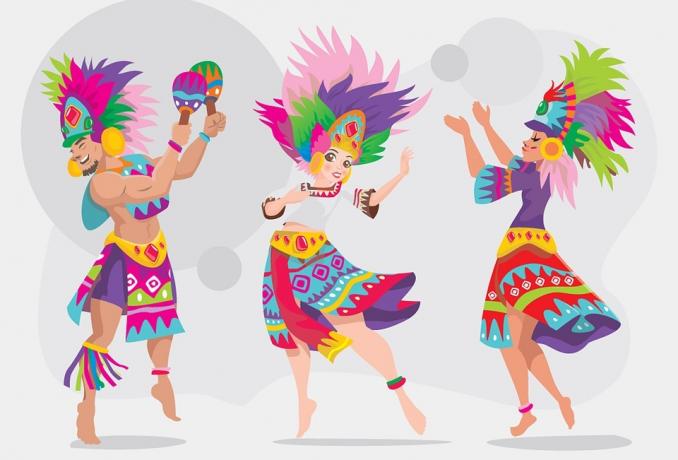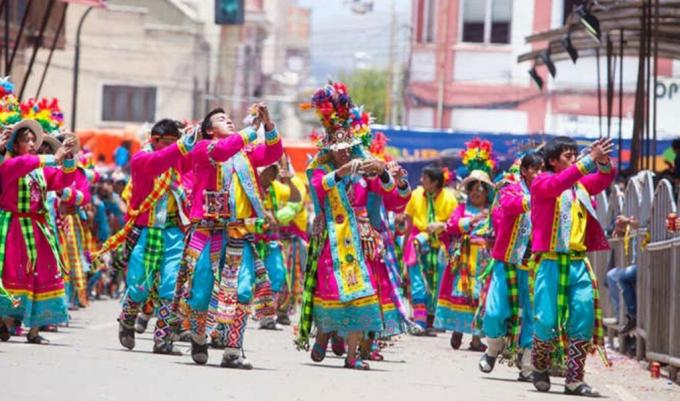Check this post for some suggestions for Texts about Carnival, ready to print. Check out some in this post. Beautiful texts about Carnival with illustrations to color and work in the initial series (Educação Infantil and Elementary School).
O Carnival it is a mobile celebration, that is, it does not have a defined day, but it is compulsorily celebrated on a Tuesday. Brazil is known worldwide for this celebration, which every year brings many tourists.
See too:
Originally, the term “carnival” means “farewell to meat” (carnis levale, in Latin), as it represented, in the Middle Ages, a time of popular festivals that preceded a period of great fasting.
Carnival was adopted by the Catholic Church as the starting point for Lent from 590 AD. Ç.
In Brazil, this popular festival began to be celebrated in the mid-seventeenth century, influenced by Europeans, who had already celebrated much earlier, mainly in France and Italy.
Index


Also check: Activities and Coloring Pages – Carnival






a few times in february
Others in March, according to
We play at Carnival.
I put an ugly face
with a huge big nose
I put on my grandfather's hat
And nobody knows who I am!
– Who are you, masked one
are you so well disguised?
– I don't know who you are either!
Let's get tired of laughing.
They can only find us
By hands, or by feet.
365 Enchanting Stories, Book “Vá de Roda”, M. Carolina Pereira Rosa
it's carnival
The children are arriving,
Singing.
bring in the look
fantasy and joy
What will they create.
It's Carnival!
And suddenly,
The room looks different.
There are streamers in the air,
there are dreams to fly
In the masks of each one.
– I'll be a fairy!
– I'll be a clown!
– I'll be a butterfly!
It's Carnival…
Manuela Martins, Book “O Sabichão”, Livraria Arnado

Carnival is when we stop being us.
Pretend you're a clown, pumpkin nose and a big bow.
Is it to be a lion, tiger or elephant
or a very good talking parrot.
It's talking to friends with a pretend voice,
change your name and don't stop laughing.
carnival is turning the world around
Legs in the air
but be careful not to spoil it.
At Carnaval
almost anything can be done
even instead of carnival
call it… Shrovetide!
Book “Pequenos Leitores 4”, Conceição Marques and Nelson Timóteo
You may have heard these names: Pierrot, Harlequin and Columbine. They are the best known characters of the carnival and are present at parties and marchinhas. The multicolored costumes of these figures gave rise to the costumes used in carnival balls and are some of the ingredients of the joy of this popular festival.
Harlequin: character from the old Italian comedy, in a multicolored costume generally made of diamonds, whose function was to amuse the audience during breaks, with jokes and snorts. Columbine's boyfriend.
Columbine: main female character, girlfriend of Harlequim and companion of Pierrot. Friend, happy, beautiful, smart. She was dressed in silk or white satin, a skirt and a little hat.
Pierrot: character also from the “commedia dell'arte”, naive and sentimental. He wore very ample trousers and coat, decorated with pompoms and with a large ruffled collar.
IT'S A PARTY THAT ARRIVED MANY YEARS AGO.
OUR CARNIVAL HAS ORIGIN IN A PARTY
PORTUGUESE CALL ENTRUDO. IN BRAZIL, THE
CARNIVAL IS FROM SATURDAY TO TUESDAY,
FORTY DAYS BEFORE HOLY WEEK.
THE PARTY IS BIG IN MUCH OF THE WORLD.
NOW THAT YOU KNOW A LITTLE MORE
ABOUT THE CARNIVAL, SOME CARE MUST BE
TAKEN TO GUARANTEE A WELL PARTY
QUIET, CHOOSE A SAFE PLACE (US
CHILDREN'S DANCES OR CLOSE TO YOUR PARENTS); NO
STOP WALKING WITH ANY IDENTIFICATION;
TAKE LIQUIDS; DON'T FORGET THE FANTASY AND
GOOD FUN!

Carnival, the most popular festival in Brazil, takes place in February or March, in the three days before Lent. And a mobile party, that is, it has no fixed date.
It is not known exactly how Carnival came about. It seems to have originated in Ancient Rome.
The Brazilian Carnival began with the Shrovetide, a popular festival brought by the Portuguese. Shrovetide manifested itself in the period of colonial Brazil and also in the Empire. In Recife it still exists today. At this party, the revelers threw water, eggs, flour, powders of various kinds, such as lime, etc., at each other. As the celebrations became more and more violent, Shrovetide ended up being banned.
The first samba school, Let Falar, dates back to 1920. Today, samba schools are registered civil societies, made up of groups of organized and costumed revelers who compete for prizes among themselves. They sing plot sambas with themes featuring legends, myths, historical events, great Brazilian figures. The biggest and most famous are those in Rio de Janeiro. Who has not heard of Portela, Estação Primeira de Mangueira, Império Serrano, Beija-Flor, Imperatriz Leopoldinense, Mocidade Independente de Padre Miguel?
The samba school parades are well-known shows that attract thousands of tourists from all over the world. The parade obeys certain rules, among which the presentation of open wings, front commission, flag bearer and master of the hall and dancers.
Several rhythms have already animated Carnival, but today samba, carnival marches and frevo predominate. Among the great composers of carnival music from the past, we can mention: Chiquinha Gonzaga. Noel Rosa, Pixinguinha, Lamartine Babo, Ari Barroso.
In this festive season,
We wish all Peoples...
A Carnival full of Easter…
And a Christmas full of New Years….
That Santa's reindeer,
Arise in the skies to Fly,
Clinking happily...
With Rudolph blinking!
That Santa Claus and the elves,
Make raves out and about...
And don't get mixed up in your boots...
When it's time to offer!….
That the Christmas nativity scene,
Have smiling stars,
Little sheep and shepherds…
And Reis Magos are happy!
May everything appear in smiles,
With a lot of peace and affection...
And that Easter bunny,
Do your best on the shoe!
That you have on this court,
Much love and joy...
French toast and children
Sweet rice and noodles!

The mixture of European tradition with the musical rhythms of Africans created in Brazil one of the greatest popular shows in the world. Carnival was born in Egypt, passed through Greece and Rome, was adapted by the Catholic Church and landed here in the 17th century, brought by the Portuguese. Live the fun!
“Who invented Brazil?/ It was Mr. Cabral, it was Mr. Cabral/ On the 22nd of April/ Two months after Carnival” (História do Brasil, Lamartine Babo, 1934)
With the History of Brazil, Lamartine Babo (1904-1963) did more than the great 1934 hit: it gave a classic definition of the party and the country. The height of this one, only that of Assis Valente (1911-1958), in Alegria: “My people were sad, bitter / He invented drums / To stop suffering / Save the pleasure / Save the pleasure”.
Below the Equator, where there is no sin, the fusion of European tradition with African drumming liberated Carnival to its fullest. Nowhere did it acquire the dimension it achieved in Brazil. For four days, the country is closed for balance. Or better: it stays open to just swing. And he indulges in the spectacle that seduces and dazzles foreigners.
The whole spree comes from people's unconscious, from fertility rituals and pagan harvest festivals.
It dates back to the celebrations of the goddess Isis and the bull Apis, in Egypt, and the goddess Herta, of the Teutonic, passing by by the Greek Dionysian rituals and by the licentious Bacchanals, Saturnales and Luoercais, the sumptuous orgies Romans.
The Saturnais were celebrated from December 16th to 18th, in honor of Saturn. Courts and schools closed their doors, slaves were freed, the streets were danced in a great and equal din. The opening was a procession of cars imitating ships, with naked men dancing frantically and obscenely the carrun navalis. For many, the expression meat is derived from this.
On February 15th, the Lupercais, dedicated to fertility, were celebrated. The lupercos, priests of Pan, came out naked, bathed in goat's blood, and chased passersby hitting them with a leash.
In March, the Bacchanals honored Bacchus (the Greek god Dionysus in the Roman version), celebrating spring inspired by Como and Momo, among other gods.
Taking control of the thing, the Church did what it could to purify the egalitarian permissiveness of the carnivals. In the sixth century, it adopted these libertarian festivals that inverted the order of everyday life, in order to domesticate them. The party became a liturgical reenactment, a humpback race, a knight dispute and an urban battle of eggs, water and flour. He put together all the parties on the eve of Lent as a compensation for the abstinence that precedes Easter. Carnival, then, spread around the world. Landed in Brazil in the 17th century. Here, it became one of the greatest shows in the world.
Anthropologist Roberto DaMatta defines revelry as a rite of inversion, which subverts everyday hierarchies: transforming the poor into pharaohs, rich into masked men, men into women, modesty into luxury. And a compensation for reality. We invented drumming to stop suffering.
Ricardo Arnt. In: Revista Superinteressante, February/95 – adapted text.
Subscribe to our email list and receive interesting information and updates in your email inbox
Thanks for signing up.
